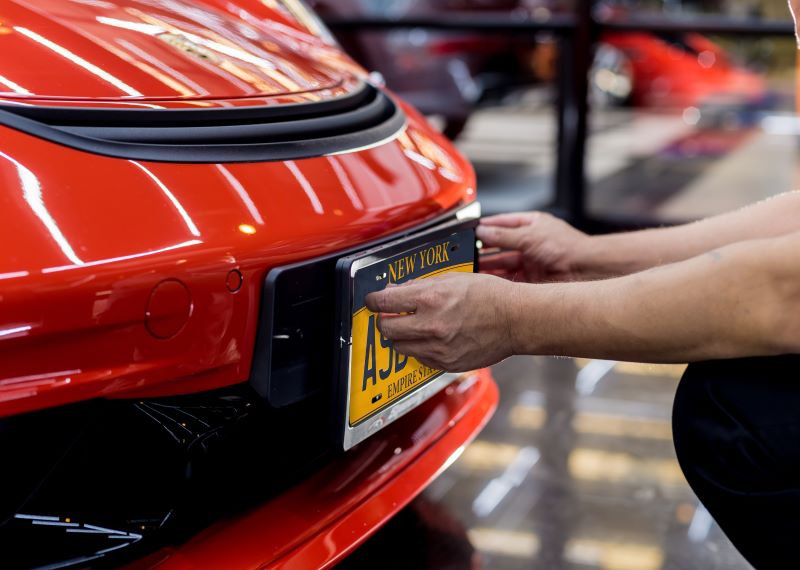Should I Wait to Buy a Car? Yes, wait if market conditions are unfavorable or personal finances are tight.
No, buy if deals are excellent and finances stable. Introduction Buying a car is a significant financial decision that requires careful consideration. Market conditions, interest rates, and personal financial stability are crucial factors to evaluate. Current market trends can heavily influence car prices, making it either a buyer’s or a seller’s market.
Assessing your financial health is equally important to ensure you can afford ongoing costs like insurance, maintenance, and fuel. By weighing these factors, you can make a more informed decision on whether to buy a car now or wait for a more opportune time. Making the right choice can save you money and provide long-term satisfaction.

Current Market Trends
Buying a car is a big decision. Many people wonder, “Should I wait to buy a car?” Current market trends play a crucial role in this decision. Understanding these trends helps you make an informed choice. This section explores two key trends: price fluctuations and supply chain issues.
Price Fluctuations
Car prices can change frequently. Understanding price trends helps you decide the best time to buy. Several factors influence car prices:
- Economic conditions: A strong economy can lead to higher car prices. A weak economy might lower prices.
- Interest rates: Low-interest rates make car loans cheaper, increasing demand and prices. High rates do the opposite.
- Seasonal trends: Prices often drop at the end of the year when dealers clear old inventory. Summer months may see higher prices due to increased demand.
Here’s a table showing how different factors affect car prices:
| Factor | Effect on Price |
|---|---|
| Strong Economy | Higher Prices |
| Weak Economy | Lower Prices |
| Low-Interest Rates | Higher Prices |
| High-Interest Rates | Lower Prices |
| End of Year | Lower Prices |
| Summer Months | Higher Prices |
Monitoring these trends helps you find the best deals. Always keep an eye on the market and stay informed about economic changes.
Supply Chain Issues
Supply chain issues also impact car buying decisions. Disruptions in the supply chain can lead to shortages and higher prices. Several factors contribute to supply chain problems:
- Global events: Natural disasters, pandemics, or political events can disrupt manufacturing and shipping.
- Chip shortages: Modern cars rely on computer chips. A shortage can slow down production and increase prices.
- Logistics challenges: Delays in shipping and transportation can affect car availability.
Here’s a table summarizing the impact of supply chain issues:
| Supply Chain Issue | Impact on Car Prices |
|---|---|
| Global Events | Higher Prices |
| Chip Shortages | Higher Prices |
| Logistics Challenges | Higher Prices |
Staying updated on supply chain news helps you understand price changes. Knowing the reasons behind price hikes or drops can guide your decision to buy now or wait.

Credit: m.youtube.com
Interest Rates Impact
Thinking about buying a car can be exciting, but many factors play a role in the decision. Interest rates are one of the most significant factors that impact the overall cost of the vehicle. Interest rates affect the monthly payments and total amount paid over the life of the loan. Understanding how interest rates impact your car purchase can help you make an informed decision.
Loan Costs
Loan costs are directly influenced by interest rates. When interest rates are high, the cost of borrowing money increases, leading to higher monthly payments. Conversely, lower interest rates mean lower monthly payments. Here’s a breakdown of how interest rates affect loan costs:
- Higher interest rates lead to more money paid in interest over the life of the loan.
- Lower interest rates result in less money paid in interest, making the loan more affordable.
To better understand the impact, let’s look at an example:
| Loan Amount | Interest Rate | Monthly Payment | Total Interest Paid |
|---|---|---|---|
| $20,000 | 3% | $359 | $1,529 |
| $20,000 | 5% | $377 | $2,645 |
As you can see from the table, a higher interest rate increases the monthly payment and the total interest paid. Understanding these costs helps you plan your budget effectively.
Financing Options
Financing options vary depending on the lender and your credit score. Some common financing options include:
- Dealer Financing: Often convenient, but may come with higher interest rates. Always compare offers.
- Bank or Credit Union Loans: Typically offer competitive interest rates. Good for those with strong credit.
- Online Lenders: Provide quick approval and competitive rates. Ensure the lender is reputable.
Your credit score plays a crucial role in determining the interest rate you qualify for. Here’s how different credit scores impact interest rates:
| Credit Score | Interest Rate |
|---|---|
| Excellent (750+) | 2-4% |
| Good (700-749) | 4-6% |
| Fair (650-699) | 6-9% |
| Poor (600-649) | 9-12% |
Choosing the right financing option and understanding your credit score will help you get the best deal. Always shop around and compare different financing options before making a decision.
Seasonal Buying Patterns
Buying a car can be a significant decision. Understanding seasonal buying patterns can help you save money. These patterns reveal the best times to make a purchase. Timing your car purchase can lead to substantial discounts and better deals. Let’s explore the most optimal periods to buy a car and the benefits of holiday sales events.
Best Times To Buy
Timing your car purchase is crucial. Certain times of the year offer better deals. Here’s a breakdown:
- End of the Month: Dealers aim to meet monthly sales targets. They may offer better deals.
- End of the Quarter: March, June, September, and December are key months. Dealers push for quarterly targets.
- End of the Year: December is a prime time. Dealers clear out inventory for new models.
Let’s look at a table for a clearer view:
| Time of Year | Reason |
|---|---|
| End of the Month | Monthly sales targets |
| End of the Quarter | Quarterly sales targets |
| End of the Year | Clear old inventory |
These periods are ideal for buying a car. Dealers are motivated to sell. This can lead to substantial savings. Always do your research and compare prices during these times. You may find the best deals and incentives.
Holiday Sales Events
Holiday sales events are another great time to buy a car. Dealers often offer significant discounts. Major holidays with sales events include:
- Presidents’ Day: February sales events offer great deals.
- Memorial Day: May sales events with attractive discounts.
- Fourth of July: Independence Day deals with special offers.
- Labor Day: September brings end-of-summer sales.
- Black Friday: November features significant discounts and promotions.
- Christmas: December has year-end clearance sales.
These holidays are perfect for finding deals. Dealers provide special financing options and rebates. The competition among dealerships increases, leading to better deals for customers. Always check for promotions and compare prices during these events.
To maximize savings, you can also combine these events with the best times to buy. This strategy ensures you get the most value for your money. Remember to visit multiple dealerships and negotiate to get the best price.
Used Vs. New Cars
Deciding whether to buy a new or used car can be a tough choice. Both options have their benefits and drawbacks. Understanding these can help make the decision easier. It’s important to weigh factors like cost, depreciation, and availability before making a choice.
Depreciation Factors
One major difference between new and used cars is depreciation. New cars depreciate quickly. The moment you drive a new car off the lot, it loses value. On average, a new car loses about 20% of its value in the first year. Within five years, it can lose up to 60% of its value.
Here are some points to consider:
- First-year depreciation: New cars lose around 20% of their value.
- Five-year depreciation: New cars can lose up to 60% of their value.
- Used cars: Generally, used cars have already experienced significant depreciation. This means they hold their value better over time.
Below is a table to summarize depreciation rates:
| Car Type | 1st Year Depreciation | 5-Year Depreciation |
|---|---|---|
| New Car | 20% | 60% |
| Used Car | Less than 20% | Less than 60% |
Availability Issues
Availability can also affect your decision. New cars are readily available from dealers. You can choose the exact model, color, and features you want. This means less waiting time and fewer compromises.
Used cars are different. The availability of used cars depends on the market. You may have to search more to find the right car. The car may not have all the features you want. Or, it may have more wear and tear.
Here are some availability factors to consider:
- New Cars: Easy to find, customizable, no waiting.
- Used Cars: Market-dependent, may need to search more, possible wear and tear.
Availability can impact your buying timeline. If you need a car immediately, a new car may be the better choice. If you have time to search, a used car could save you money.
Your Financial Situation
Buying a car is a significant financial decision. Your financial situation plays a crucial role in determining if you should wait to buy a car. Considering factors like your budget and credit score can help you make an informed choice.
Budget Considerations
Before buying a car, assess your budget. Calculate your monthly income and expenses. Ensure you have enough money for car payments and other expenses. It’s important to have a clear picture of your finances.
Think about these key points:
- Monthly Income: How much money do you earn each month?
- Monthly Expenses: What are your regular monthly bills and expenses?
- Savings: Do you have savings set aside for emergencies?
- Down Payment: How much can you afford to put down on a car?
- Loan Payments: What will your monthly car payment be?
Below is a simple table to help you organize your budget:
| Item | Amount |
|---|---|
| Monthly Income | $____ |
| Monthly Expenses | $____ |
| Savings | $____ |
| Down Payment | $____ |
| Loan Payments | $____ |
Make sure to keep some buffer for unexpected expenses. Don’t stretch your budget too thin. Having a clear understanding of your budget can prevent financial stress later.
Credit Score Effects
Your credit score impacts your car purchase. A high credit score can get you better loan rates. If your score is low, it might be better to wait and improve it.
Here’s how your credit score affects your car buying experience:
- Interest Rates: Higher credit scores usually mean lower interest rates.
- Loan Approval: Lenders are more likely to approve loans for higher scores.
- Down Payment Requirements: Lower scores might require higher down payments.
Check your credit score before buying a car. You can get a free credit report annually from the three major credit bureaus. Work on improving your score if needed.
Ways to improve your credit score:
- Pay bills on time
- Reduce credit card balances
- Avoid opening new credit accounts
- Dispute inaccuracies on your credit report
Taking steps to improve your credit score can save you money in the long run. A better credit score means better loan terms. This can make your car purchase more affordable.

Credit: hermoney.com
Future Vehicle Technology
Thinking about buying a car? With technology rapidly advancing, the decision can be tricky. Future vehicle technology is evolving fast, making cars smarter, safer, and more efficient. This evolution might make you wonder if it’s worth waiting for the latest innovations before making a purchase.
Electric Vehicles
Electric vehicles (EVs) are transforming the automotive industry. They offer numerous benefits, including environmental and economic advantages. Here are some key points to consider:
- Lower Emissions: EVs produce zero tailpipe emissions, reducing air pollution and helping the environment.
- Cost Savings: EVs have fewer moving parts, resulting in lower maintenance costs. Electricity is also cheaper than gasoline.
- Government Incentives: Many countries offer tax rebates and incentives for EV buyers, making them more affordable.
The technology in EVs is also rapidly improving. New models feature extended battery life, faster charging times, and increased driving ranges. Here’s a comparison of some popular EV models:
| Model | Range (miles) | Charging Time | Price |
|---|---|---|---|
| Tesla Model 3 | 358 | 8.5 hours | $39,990 |
| Nissan Leaf | 226 | 7.5 hours | $31,620 |
| Chevrolet Bolt | 259 | 9.5 hours | $36,500 |
As battery technology improves, expect even longer ranges and shorter charging times. Waiting a bit longer could mean getting a more advanced and efficient EV.
Autonomous Features
Autonomous features are another exciting development in vehicle technology. These features make driving safer and more convenient. Here are some of the key autonomous features available today:
- Adaptive Cruise Control: This system automatically adjusts your speed to maintain a safe distance from the car ahead.
- Lane Keeping Assist: Helps keep your car centered in its lane by gently steering if you start to drift.
- Automatic Emergency Braking: Detects potential collisions and applies the brakes to prevent or reduce impact.
Future cars will have even more advanced autonomous features. Imagine a car that drives itself, allowing you to relax or focus on other tasks. Here’s a look at some upcoming autonomous technologies:
| Feature | Description | Expected Year |
|---|---|---|
| Full Self-Driving | The car can drive itself without any human intervention. | 2024 |
| Advanced Parking Assist | The car can find a parking spot and park itself. | 2023 |
| Traffic Jam Assist | The car can navigate through heavy traffic autonomously. | 2023 |
Waiting for these technologies could be beneficial. They will make driving safer and more enjoyable. Imagine a future where your car takes care of driving, allowing you to relax.
Insurance Costs
Buying a car involves many considerations. One of the major factors is the cost of insurance. Insurance costs can significantly impact your decision. Understanding how insurance rates vary and what types of coverage are available can help you make an informed choice.
Premium Variations
Insurance premiums can vary widely. Several factors influence these variations, including:
- Age: Younger drivers often pay higher premiums due to less driving experience.
- Driving history: A clean driving record can lead to lower rates, while accidents and violations increase costs.
- Location: Urban areas usually have higher premiums due to increased traffic and accident risks.
- Vehicle type: Expensive or high-performance cars typically have higher insurance rates.
- Credit score: In many places, a higher credit score can result in lower premiums.
Below is a table that shows average insurance premiums based on different factors:
| Factor | Average Premium |
|---|---|
| Young Driver (Age 18-25) | $2,500 |
| Experienced Driver (Age 26-45) | $1,200 |
| Clean Driving Record | $1,000 |
| Minor Violations | $1,500 |
| Urban Area | $1,800 |
| Rural Area | $1,000 |
| High-Performance Car | $2,200 |
| Family Sedan | $1,100 |
Coverage Types
Insurance policies offer different types of coverage. Knowing what each type covers can help you decide what you need. Here are some common coverage types:
- Liability Coverage: This covers damages and injuries you cause to others. It’s often mandatory.
- Collision Coverage: This pays for repairs to your car after an accident, regardless of fault.
- Comprehensive Coverage: This covers non-collision incidents, like theft, fire, or natural disasters.
- Personal Injury Protection (PIP): This covers medical expenses and lost wages for you and your passengers.
- Uninsured/Underinsured Motorist Coverage: This protects you if you’re hit by a driver with insufficient or no insurance.
Here is a table summarizing the different coverage types and what they include:
| Coverage Type | What It Covers |
|---|---|
| Liability | Damages to others |
| Collision | Repairs to your car |
| Comprehensive | Theft, fire, natural disasters |
| PIP | Medical expenses, lost wages |
| Uninsured/Underinsured Motorist | Protection against insufficient insurance |
Understanding these coverage types helps you choose the right insurance policy. It ensures you get the best protection for your needs.

Credit: m.youtube.com
Long-term Ownership Costs
Deciding when to buy a car involves more than just the sticker price. One crucial aspect to consider is the long-term ownership costs. These costs include maintenance expenses, fuel efficiency, insurance, and depreciation. Understanding these can help you make a more informed decision.
Maintenance Expenses
Maintenance expenses are a significant part of owning a car. These include routine services like oil changes, tire rotations, and brake checks. Besides regular upkeep, unexpected repairs can also arise. Older cars may require more frequent fixes, leading to higher costs.
Regular maintenance tasks include:
- Oil changes every 3,000 to 5,000 miles
- Tire rotations every 6,000 to 8,000 miles
- Brake inspections annually or as needed
Let’s look at a comparison table for maintenance costs over five years:
| Car Age | Yearly Maintenance Cost |
|---|---|
| 1-3 years | $300 – $500 |
| 4-6 years | $500 – $800 |
| 7+ years | $800 – $1,200 |
Newer cars often come with warranties that cover many repairs. This can save you money in the first few years. Older cars, though cheaper upfront, can become more expensive due to higher maintenance costs.
Fuel Efficiency
Fuel efficiency is another important factor in long-term car ownership costs. Cars with better fuel efficiency save you money at the pump. This is especially important as fuel prices can fluctuate.
Consider the following points about fuel efficiency:
- Hybrid cars often get 50+ miles per gallon (MPG)
- Electric vehicles (EVs) avoid fuel costs altogether, though they have charging costs
- Traditional gas cars average around 25-30 MPG
Here’s a comparison of annual fuel costs based on different fuel efficiencies:
| Fuel Efficiency (MPG) | Annual Fuel Cost (assuming 12,000 miles/year) |
|---|---|
| 20 MPG | $1,800 |
| 30 MPG | $1,200 |
| 50 MPG | $720 |
Choosing a car with higher fuel efficiency can lead to substantial savings over time. This is particularly true if you drive a lot. Electric vehicles, while often more expensive upfront, can be cheaper in the long run due to lower energy costs.
Our Methodology
Frequently Asked Questions
Is Now A Good Time To Buy A Car?
It depends on market conditions and personal finances. Research current car prices and interest rates. Consider your immediate need for a vehicle.
Should I Buy A New Or Used Car?
New cars offer the latest features but depreciate faster. Used cars are cheaper but may require more maintenance. Choose based on budget and preferences.
How Does The Economy Impact Car Prices?
Economic factors like inflation and interest rates affect car prices. In a strong economy, prices may rise. In a recession, prices may drop.
What Are The Benefits Of Waiting To Buy A Car?
Waiting can lead to better deals, newer models, and improved technology. It also allows time to save more money for a down payment.
Conclusion
Deciding whether to buy a car now depends on your personal situation. Evaluate your financial readiness and current market conditions. Consider future trends and your immediate transportation needs. Make an informed decision that aligns with your lifestyle and budget. This will ensure you make the best choice for your circumstances.



